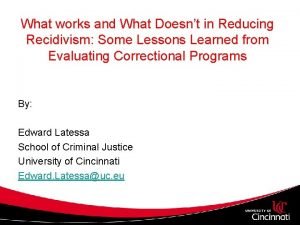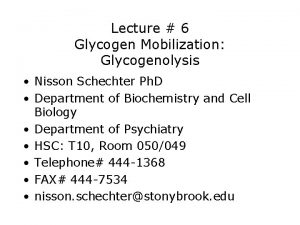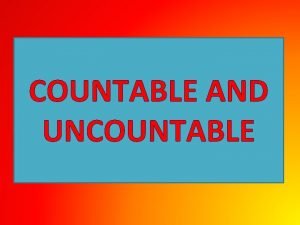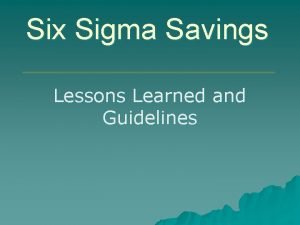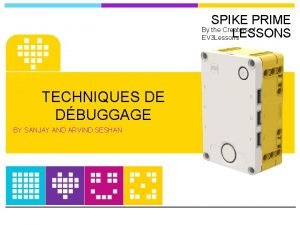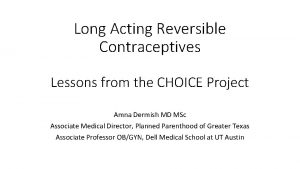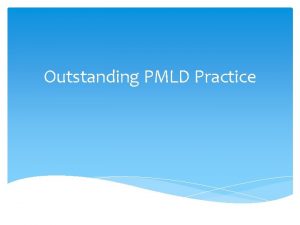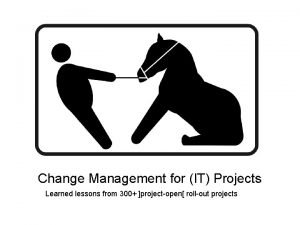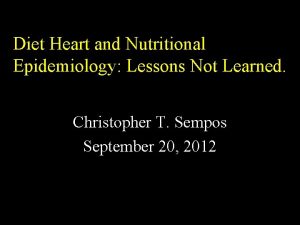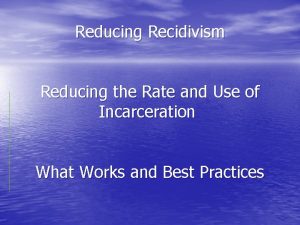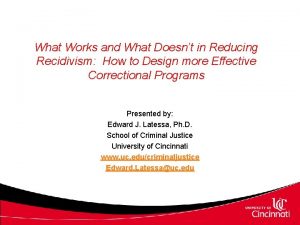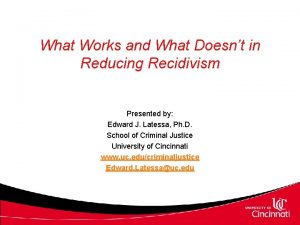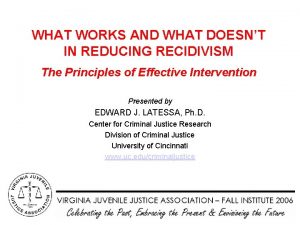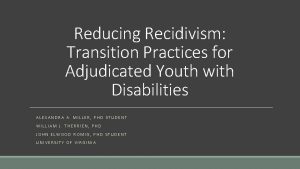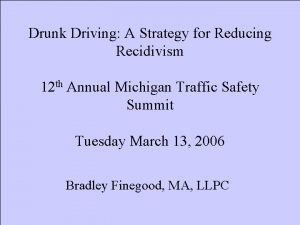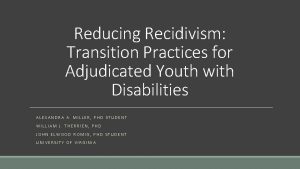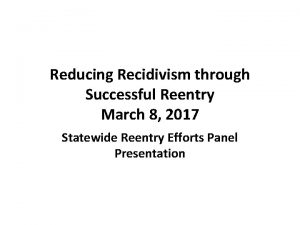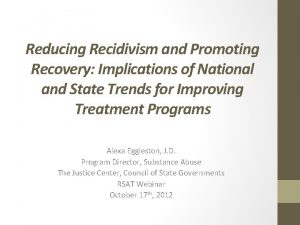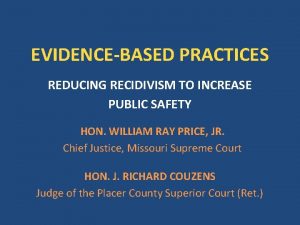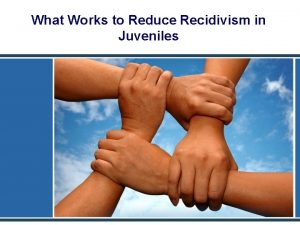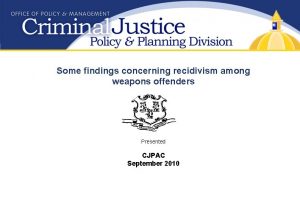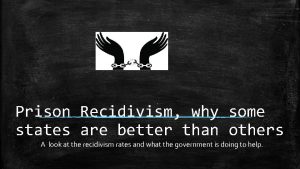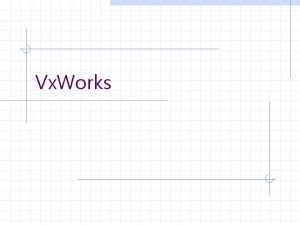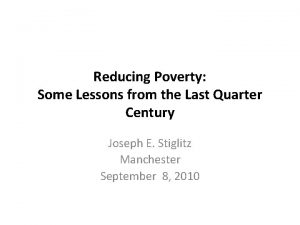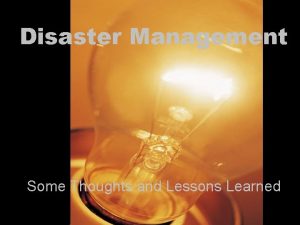What Works in Reducing Recidivism Some Lessons I
























































- Slides: 56

What Works in Reducing Recidivism: Some Lessons I have Learned over the Years Evaluating Correctional Programs By: Edward Latessa School of Criminal Justice University of Cincinnati

Lesson 1 • Some things don’t work

Some so called “theories” we have come across • “Offenders lack creativity theory” • “Offenders need to get back to nature theory” • “Offenders need discipline and physical conditioning theory” • “Offenders need to change their diet theory” • “Treat them as babies & dress them in diapers theory” • “We just want them to be happy theory” • “Male offenders need to get in touch with their feminine side theory”









DOGSLEDDING AS RESTORATIVE JUSTICE METHOD – London Free Press – 07/03/11 The Hollow Water First Nation, who live 200 km northeast of Winnipeg, have used dogsledding as a restorative justice program, which tries to restore relationships between victims and perpetrators in criminal cases. Exercising wilderness skills was seen as a way of rebuilding the perpetrator’s self-esteem, explained Marcel HARDESTY, restorative justice program director.

Lesson 2 • If you want to reduce recidivism focus on the offenders most likely to recidivate


Lesson 3 • Sometimes we fail because we do not provide enough treatment

Provide Most Intensive Interventions to Higher Risk Offenders • Higher risk offenders will require much higher dosage of treatment – Rule of thumb: 100 hours for moderate risk – 200+ hours for higher risk – 100 hours for high risk will have little if any effect – Does not include work/school and other activities that are not directly addressing criminogenic risk factors

2010 Study (Latessa, Sperber and Makarios) Recidivism Rates by Treatment Intensity and Risk Levels 90 Percent Returnned for a New Crime 80 70 60 50 0 -99 Tx hours 40 100 -199 Tx hours 200+ Tx hours 30 20 10 0 low 0 -99 Tx hours 100 -199 Tx hours 200+ Tx hours moderate high Hours of Treatment By Risk Level low 39 26 moderate 52 45 43 overall high Average low=78, Moderate= 155 High =241 81 57 overall 46 43 48

Lesson 4 • Some times we fail because we provide intensive programs to the wrong offenders

Intensive Treatment for Low Risk Offenders will often Increase Failure Rates • Low risk offenders will learn anti social behavior from higher risk • Disrupts prosocial networks

2002 STUDY OF COMMUNITY CORRECTIONAL PROGRAMS IN OHIO • Largest study of community based correctional treatment facilities ever done up to that time • Total of 13, 221 offenders – 37 Halfway Houses and 15 Community Based Correctional Facilities (CBCFs) were included in the study. • Two-year follow-up conducted on all offenders • Recidivism measures included new arrests & incarceration in a state penal institution

Reduced Recidivism Increased Recidivism


2010 STUDY OF COMMUNITY CORRECTIONAL PROGRAMS IN OHIO • Over 20, 000 offenders – 44 Halfway Houses and 20 Community Based Correctional Facilities (CBCFs) were included in the study. • Two-year follow-up conducted on all offenders

-60 Harbor Light--D/A Comp. Drug MONDAY Oriana RIP Oriana CCTC West Central CATS male RTP TH Turtle Creek Cinti VOA SOT AH Alum Creek Harbor Light--Corr Alternatives Franklin STARK WORTH CTCC Canton NEOCAP Oriana TMRC TH Springrove Oriana Summit Pathfinder Oriana Cliff Skeen ALL CBCF FACILITIES EOCC Female ALL HWH FACILITIES Lorain-Medina Mahoning Oriana Crossweah River City STAR Talbert House CCC Booth H/Salv A CCA RTC II Cinti VOA D/A Comm Trans Ctr Crossroads Diversified Fresh Start SOS TH Pathways AH Dunning ARCA Oriana RCC Licking-Muskingum CATS female RTP Mansfield VOA SEPTA TH Cornerstone EOCC Male Lucas AH Price AH Veterans Dayton VOA Small Programs Toledo VOA Northwest CCC TH Beekman CATS male TC % Difference in Rate of New Felony Conviction Treatment Effects for Low Risk 60 50 40 30 20 10 0 -10 -20 -30 -40 -50

-60 AH Veterans TH Beekman MONDAY CTCC Canton TH Springrove Northwest CCC WORTH Diversified Oriana CCTC Oriana Summit Oriana Crossweah ARCA Booth H/Salv A CATS male RTP Crossroads Franklin Comm Trans Ctr STARK River City Talbert House CCC West Central EOCC Male ALL CBCF FACILITIES Comp. Drug AH Dunning Alternatives CCA RTC II Small Programs Harbor Light--D/A ALL HWH FACILITIES Oriana TMRC CATS male TC Fresh Start Dayton VOA NEOCAP Harbor Light--Corr Oriana RIP Licking-Muskingum Mahoning Cinti VOA D/A Oriana RCC STAR SOS Lucas CATS female RTP AH Price TH Turtle Creek Lorain-Medina Pathfinder Toledo VOA EOCC Female Oriana Cliff Skeen SEPTA AH Alum Creek Mansfield VOA TH Cornerstone CCA RTC I % Difference in Rate of New Felony Conviction Treatment Effects for High Risk 60 50 40 30 20 10 0 -10 -20 -30 -40 -50

Average Difference in Recidivism by Risk for Halfway House Offenders Low risk ↑ recidivism by 3% Moderate risk ↓ recidivism by 6% High risk ↓ recidivism by 14%

Lesson 5 • It is important to understand that even with EBP there will be failures.

• • Example of Targeting Higher Risk Offenders If you have 100 High risk offenders about 60% will fail If you put them in well designed EBP for sufficient duration you may reduce failure rate to 40% If you have 100 low risk offenders about 10% will fail If you put them in same program failure rate will be 20%

Targeting Higher Risk Offenders continued: • In the end, who had the lower recidivism rate? • Mistake we make is comparing high risk to low risk rather than look for treatment effects

Lesson 6 • Everyone thinks they are an expert in criminal behavior

Major Set of Risk/Need Factors 1. Antisocial/procriminal attitudes, values, beliefs & cognitive emotional states 2. Procriminal associates & isolation from anticriminal others 3. Temperamental and anti social personality patterns conducive to criminal activity including: Ø Weak socialization Ø Impulsivity Ø Adventurous Ø Restless/aggressive Ø Egocentrism Ø A taste for risk Ø Weak problem-solving/self-regulation & coping skills 4. A history of antisocial behavior

Major Set of Risk/Need Factors 5. Familial factors that include criminality and a variety of psychological problems in the family of origin including: Ø Low levels of affection, caring, and cohesiveness Ø Poor parental supervision and discipline practices Ø Outright neglect and abuse 6. Low levels of personal, educational, vocational, or financial achievement 7. Low levels of involvement in prosocial leisure activities 8. Substance Abuse

Recent study of parole violators in Pennsylvania found a number of criminogenic factors related to failure* *Conducted by Pennsylvania Dept. of Corrections

Pennsylvania Parole Study Social Network and Living Arrangements Violators Were: • More likely to hang around with individuals with criminal backgrounds • Less likely to live with a spouse • Less likely to be in a stable supportive relationship • Less likely to identify someone in their life who served in a mentoring capacity

Pennsylvania Parole Study Employment & Financial Situation Violators were: • • • Slightly more likely to report having difficulty getting a job Less likely to have job stability Less likely to be satisfied with employment Less likely to take low end jobs and work up More likely to have negative attitudes toward employment & unrealistic job expectations • Less likely to have a bank account • More likely to report that they were “barely making it” (yet success group reported over double median debt)

Pennsylvania Parole Study Alcohol or Drug Use Violators were: • More likely to report use of alcohol or drugs while on parole (but no difference in prior assessment of dependency problem) • Poor management of stress was a primary contributing factor to relapse

Pennsylvania Parole Study Life on Parole Violators were: • Had unrealistic expectations about what life would be like outside of prison • Had poor problem solving or coping skills – Did not anticipate long term consequences of behavior • Failed to utilize resources to help them – Acted impulsively to immediate situations – Felt they were not in control • More likely to maintain anti-social attitudes – Viewed violations as an acceptable option to situation – Maintained general lack of empathy – Shifted blame or denied responsibility

Pennsylvania Parole Violator Study: • Successes and failures did not differ in difficulty in finding a place to live after release • Successes & failures equally likely to report eventually obtaining a job

Lesson 7 Offenders are not High Risk because they have a Risk Factor… they have Multiple Risk Factors

Targeting Criminogenic Need: Results from Meta. Analyses Reduction in Recidivism Increase in Recidivism Source: Gendreau, P. , French, S. A. , and A. Taylor (2002). What Works (What Doesn’t Work) Revised 2002. Invited Submission to the International Community Corrections Association Monograph Series Project

Lesson 8 • Doing things well makes a difference


Program Integrity and Recidivism • Several large studies we have done recently have found a strong relationship between program integrity and recidivism • Higher the program’s integrity score – greater the reductions in recidivism

Program Integrity—Relationship Between Program Integrity Score & Treatment Effects Reduced Recidivism Increased Recidivism 0 -30 31 -59 60 -69 70+

Program Integrity—Relationship Between Program Integrity Score And Treatment Effect for Community Supervision Programs Reduced Recidivism Increased Recidivism

Impact of Program Factors Predicting Felony Adjudication for Juvenile Programs

2009 Study of Community Corrections Centers and Parolees in Pennsylvania • Recidivism rates for offenders in Community Correctional facilities were higher than those under supervision • Of the 54 programs, 93% were rated as “needs improvement” or ineffective on the Correctional Program Checklist

Findings- Recidivism Rates for Successful Completers vs. Comparison Group

Lesson 9 • Changing behavior isn’t easy, but we can do it – we just need to go about it the right way

Effective Correctional Interventions §Use behavioral approaches: Structured Social learning model with cognitive behavioral treatment § Focus on current risk factors § Action oriented §Use reinforcement



Effective Practices in Community Supervision (EPICS) • Designed to better utilize POs as agents of Change • Translate risk, need and responsivity principles into practice • Improve relationship between PO and Offender • Focus on thought-behavior link and teach core skills in simple but concrete manner

Structure of EPICS Meeting Officers are trained to structured sessions with offenders in the following way: 1. Check-In 2. Review 3. Intervention 4. Homework and Behavioral Rehearsal 64

Two year Recidivism Results from Canadian Study Bont, et al, (2010) The Strategic Training Initiative in Community Supervision: Risk-Need-Responsivity in the Real World. Public . Safety Canada

Thank you
 What works and doesn't in reducing recidivism download
What works and doesn't in reducing recidivism download Recidive
Recidive What is reducing sugar
What is reducing sugar Glucose versus glycogen
Glucose versus glycogen Osazone test diagram
Osazone test diagram Reducing vs. non-reducing sugars
Reducing vs. non-reducing sugars Nrswa revision
Nrswa revision Some trust in horses
Some trust in horses Contact vs noncontact forces
Contact vs noncontact forces Sometimes you win some
Sometimes you win some Fire and ice diamante poem
Fire and ice diamante poem Sometimes you win some sometimes you lose some
Sometimes you win some sometimes you lose some Some say the world will end in fire some say in ice
Some say the world will end in fire some say in ice An ice cream countable or uncountable
An ice cream countable or uncountable Engvid quiz
Engvid quiz Lessons from nahum
Lessons from nahum Can of coke countable or uncountable
Can of coke countable or uncountable 7 plagues of egypt
7 plagues of egypt Lessons from eli
Lessons from eli Six sigma lessons learned
Six sigma lessons learned Robert hook cell
Robert hook cell I like school poem by lenore hetrick
I like school poem by lenore hetrick Golf lessons palmerston north
Golf lessons palmerston north Spike prime lessons
Spike prime lessons 7 habits of highly effective teens lessons
7 habits of highly effective teens lessons Technology applications middle school lessons
Technology applications middle school lessons Voice lessons: tone answers
Voice lessons: tone answers Lessons learned repository
Lessons learned repository Acting the first six lessons summary
Acting the first six lessons summary Lessons from hadith 18 of annawawis collection
Lessons from hadith 18 of annawawis collection Life lessons from the tower of babel
Life lessons from the tower of babel Outstanding pmld lessons
Outstanding pmld lessons John cleese sales training video
John cleese sales training video Lessons from the burning bush
Lessons from the burning bush Nde lessons
Nde lessons Chapter 1 hatchet
Chapter 1 hatchet Acts 11 lesson
Acts 11 lesson Exodus 17 8-16
Exodus 17 8-16 Lessons from shunammite woman
Lessons from shunammite woman Lessons from the life of prophet samuel
Lessons from the life of prophet samuel Lessons from exodus 5
Lessons from exodus 5 Trinity activities for sunday school
Trinity activities for sunday school Lessons from zions camp
Lessons from zions camp Ed.ted/lessons
Ed.ted/lessons Spike lessons
Spike lessons Typhoon yolanda lessons learned
Typhoon yolanda lessons learned Language lessons
Language lessons What do you often do
What do you often do Lessons learned from king josiah
Lessons learned from king josiah Change management lessons learned
Change management lessons learned Management lessons from chak de india
Management lessons from chak de india Lessons not learned in blood
Lessons not learned in blood Exodus 2 1-10 lesson
Exodus 2 1-10 lesson Leadership lessons from elijah and elisha
Leadership lessons from elijah and elisha Lessons from the life of samson
Lessons from the life of samson Dps project title
Dps project title Ozoblockly lessons
Ozoblockly lessons
